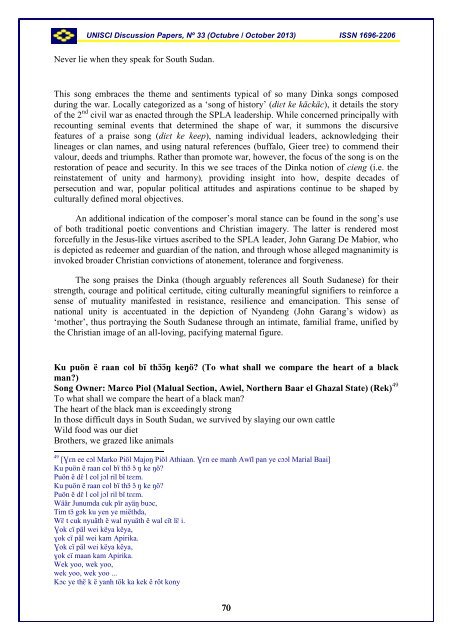UNISCI - Universidad Complutense de Madrid
UNISCI - Universidad Complutense de Madrid
UNISCI - Universidad Complutense de Madrid
Create successful ePaper yourself
Turn your PDF publications into a flip-book with our unique Google optimized e-Paper software.
<strong>UNISCI</strong> Discussion Papers, Nº 33 (Octubre / October 2013) ISSN 1696-2206Never lie when they speak for South Sudan.This song embraces the theme and sentiments typical of so many Dinka songs composedduring the war. Locally categorized as a ‘song of history’ (diɛt ke käckäc), it <strong>de</strong>tails the storyof the 2 nd civil war as enacted through the SPLA lea<strong>de</strong>rship. While concerned principally withrecounting seminal events that <strong>de</strong>termined the shape of war, it summons the discursivefeatures of a praise song (diɛt ke keep), naming individual lea<strong>de</strong>rs, acknowledging theirlineages or clan names, and using natural references (buffalo, Gieer tree) to commend theirvalour, <strong>de</strong>eds and triumphs. Rather than promote war, however, the focus of the song is on therestoration of peace and security. In this we see traces of the Dinka notion of cieng (i.e. thereinstatement of unity and harmony), providing insight into how, <strong>de</strong>spite <strong>de</strong>ca<strong>de</strong>s ofpersecution and war, popular political attitu<strong>de</strong>s and aspirations continue to be shaped byculturally <strong>de</strong>fined moral objectives.An additional indication of the composer’s moral stance can be found in the song’s useof both traditional poetic conventions and Christian imagery. The latter is ren<strong>de</strong>red mostforcefully in the Jesus-like virtues ascribed to the SPLA lea<strong>de</strong>r, John Garang De Mabior, whois <strong>de</strong>picted as re<strong>de</strong>emer and guardian of the nation, and through whose alleged magnanimity isinvoked broa<strong>de</strong>r Christian convictions of atonement, tolerance and forgiveness.The song praises the Dinka (though arguably references all South Sudanese) for theirstrength, courage and political certitu<strong>de</strong>, citing culturally meaningful signifiers to reinforce asense of mutuality manifested in resistance, resilience and emancipation. This sense ofnational unity is accentuated in the <strong>de</strong>piction of Nyan<strong>de</strong>ng (John Garang’s widow) as‘mother’, thus portraying the South Sudanese through an intimate, familial frame, unified bythe Christian image of an all-loving, pacifying maternal figure.Ku puön ë raan col bï thɔ̈ ɔ̈ ŋ keŋö? (To what shall we compare the heart of a blackman?)Song Owner: Marco Piol (Malual Section, Awiel, Northern Baar el Ghazal State) (Rek) 49To what shall we compare the heart of a black man?The heart of the black man is exceedingly strongIn those difficult days in South Sudan, we survived by slaying our own cattleWild food was our dietBrothers, we grazed like animals49 [Ɣɛn ee cɔl Marko Piöl Majoŋ Piöl Athiaan. Ɣɛn ee manh Awïl pan ye cɔɔl Marial Baai]Ku puön ë raan col bï thɔ̈ ɔ̈ ŋ ke ŋö?Puön ë dɛ̈ l col jɔl ril bï tɛɛm.Ku puön ë raan col bï thɔ̈ ɔ̈ ŋ ke ŋö?Puön ë dɛ̈ l col jɔl ril bï tɛɛm.Wäär Junumda cuk pïr ayäŋ buɔc,Tim tɔ̈ gɔk ku yen ye miëthda,Wɛ̈ t cuk nyuäth ë wal nyuäth ë wal cït lɛ̈ i.Ɣok cï päl wei këya këya,ɣok cï päl wei kam Apirika.Ɣok cï päl wei këya këya,ɣok cï maan kam Apirika.Wek yoo, wek yoo,wek yoo, wek yoo ...Kɔc ye thɛ̈ k ë yanh tök ka kek ë röt kony70
















